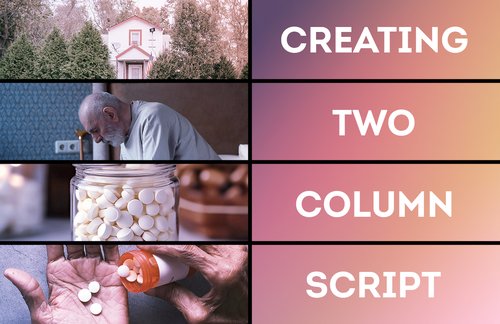
This lesson introduces the basic skills needed to combine sort-form storytelling with science by introducing students to two-column scripts. This structure facilitates an easy way to pair visuals with audio, helping students bring their ideas to life.
Students will learn:
People are attracted to information that helps them make good decisions. If you like music, you find musician interviews relevant. If you’re looking for a job, the business news is relevant. We need to depend on relevant information that helps us make decisions.
In news, it’s a story’s point or theme. It's the lens through which the producer or writer filters the information they have gathered and focuses it to make it meaningful to viewers or readers.
The people who read, watch and consume news. Often, journalists think about audience and newsworthiness in similar ways. How will the news story serve their local or national audience? Who am I writing the story for and why?
An account of past or current events. In journalism, stories are presented with a combination of people, facts, and typically includes a beginning, middle and end.
A person or other physical being in a narrative. Stories are made up of different characters who provide information and help shape the narrative with their knowledge, experience and perspective.
The process of changing and updating your work based on feedback with the goal of making it stronger. To successfully revise your story, listen to other perspectives, be open to reconsidering parts of your story and remember not to take feedback personally - it's about the story, not about you.
A document with transcribed (written-out) soundbites and voiceover narration. A VIDEO script is a two-column document with the audio (soundbites and voice over) in the right-hand column and a description of what the audience sees (visuals) in the left-hand column.
When violence strikes or when people argue about actions, events, ideas or policies, we care. Conflict and controversy attract our attention by highlighting problems or differences within the community or between groups. Sometimes conflict can be subtle and manifest as tension.
The term “empathy” is used to describe a wide range of experiences. A generally definition is the ability to sense other people’s emotions, coupled with the ability to imagine what someone else might be thinking or feeling. In media-making, creators can have empathy for their subjects and the audience can empathize with the characters.
Narration done by a broadcast reporter, usually reading from a script. The reporter's voice is recorded over a sequence of video clips that tell a story.
Something that is known or proved to be true.
A view or judgment formed about something, not necessarily based on fact or knowledge.
An investigation into and study of sources in order to establish facts and reach new conclusions.
A source is an individual, company, document or more that can provide information to fuel a new story. In order for a story to be considered verified and to maintain a reputation as a news outlet, it is important to have a credible source.
The main person or character in a story. There can be multiple subjects in a story. The subject can also be the main theme of your story.
A detailed analysis and assessment of something.
An example of using a little person to tell a big story. For example, you want to tell a story about pollution in your community’s water system. That is a big issue. Your video will use the story of a person (character) to illustrate the effects of bad water quality.
An attempt to grab the reader or viewer’s attention with interesting information that will keep them reading or watching.
Determine the kinds of sources that will be helpful in answering compelling and supporting questions, taking into consideration multiple points of view represented in the sources, the types of sources available, and the potential uses of the sources. (NCSS D1.5.9-12)
Explain points of agreement and disagreement experts have about interpretations and applications of disciplinary concepts and ideas associated with a supporting question and explain how supporting questions contribute to an inquiry and how, through engaging source work, new compelling and supporting questions emerge. (NCSS D1.3.9-12 - D1.4.9-12)
Students critically curate a variety of resources using digital tools to construct knowledge, produce creative artifacts and make meaningful learning experiences for themselves and others. (ISTE)
Students communicate clearly and express themselves creatively for a variety of purposes using the platforms, tools, styles, formats and digital media appropriate to their goals. (ISTE)
Video Production
Media Literacy
Science
Education
STEM
Beginner
Intermediate
Computers
Post It Notes
White board, chalkboard or other visual board
Markers
Slides
Projector
Camera or Mobile Phone
Mobile Phone
Internet
Online Worksheet
Padlet, Jamboard or other app for group collaboration
Notebook
1 Week